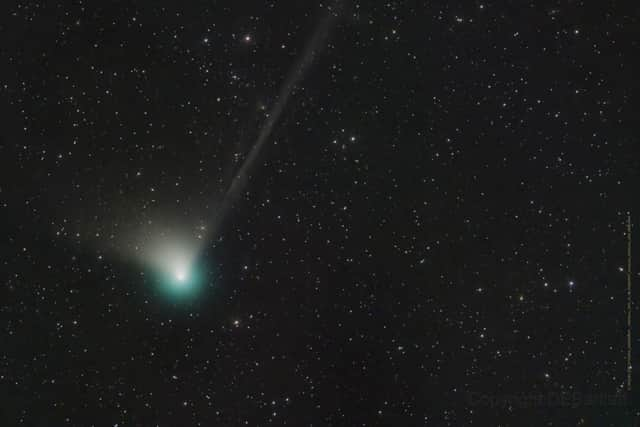Rare green comet last seen 50,000 years ago due to make closest pass by Earth
Called C/2022 E3 (ZTF), this celestial object hails from the Oort cloud at the outermost edge of the Solar System.
It will come closest to Earth on February 1, within about 45 million kilometres.
Advertisement
Hide AdAdvertisement
Hide AdThe icy ball orbits the sun once every 50,000 years, which means the last time it went past the planet was during Stone Age – when Neanderthals roamed the Earth.


Dr Greg Brown, an astronomer at the Royal Observatory Greenwich, said: “Long-period comet C/2022 E3 is currently speeding through the solar system and won’t return for at least 50,000 years, assuming it ever does, so it’s your once-in-a-lifetime chance to see it.
“Its path across our sky is taking it through the constellation of Draco the dragon and will be passing between the two bears, Ursa Major and Ursa Minor, in late January and into early February.”
C/2022 E3 was first spotted in March 2022, using the Zwicky Transient Facility in California.
Its green glow is a result of ultraviolet radiation from the sun lighting up the gases surrounding the comet’s surface.
C/2022 E3 has recently become bright enough to see with the naked eye in areas with minimal light pollution.
Dr Brown said: “While it may yet become possible to see it with the unaided eye from an extremely dark site, you are much better off pointing a pair of binoculars or a small telescope at it.
“For observers in the UK, head out after midnight when the comet will be highest in the sky and try and find the faint greenish light coming from it.
Advertisement
Hide AdAdvertisement
Hide Ad“Easiest to see will be the brighter head of the comet, but, if you are lucky, you may spot one of its two tails sweeping out from it, each made of material being jettisoned from its rapidly warming icy surface.”
Last week, an asteroid the size of a small truck passed Earth, making one of the closest approaches to the planet ever recorded.
Asteroid 2023 BU zoomed over the southern tip of South America at about 12.27am on Friday, only 2,200 miles above the Earth’s surface.
It was within the orbit of the planet’s satellites, Nasa’s Jet Propulsion Laboratory (JPL) said.